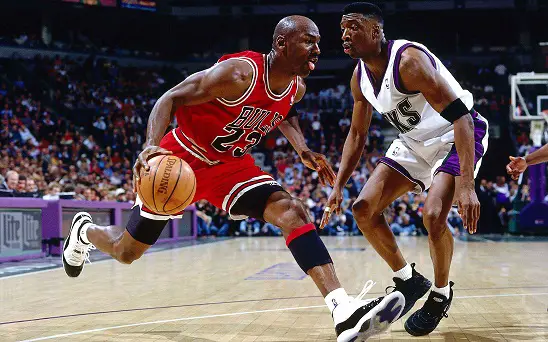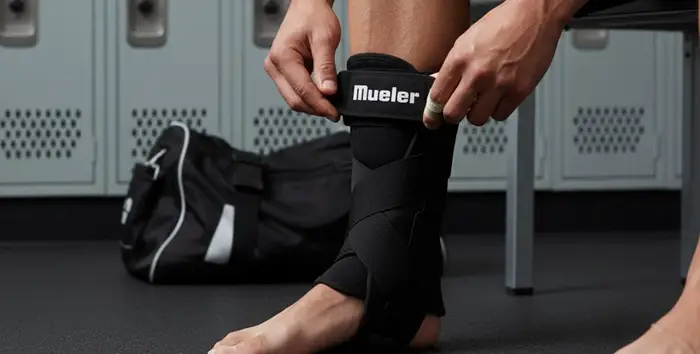
If you’ve ever tried to put on an ankle brace and ended up wrestling with it like it’s an origami project gone wrong, you’re not alone.
The Mueller ankle brace looks simple… until you actually sit down to wrap it.
But once you know the proper technique, it becomes one of the quickest ways to stabilize your ankle, reduce strain, and confidently get back on your feet—literally.
Whether you’re recovering from a sprain, protecting yourself during workouts, or simply trying to keep that “I think I twisted it again” feeling at bay, learning how to put on and wrap your Mueller brace correctly makes all the difference.
Let’s walk through it the right way—step by step.
How to Put on a Mueller Ankle Brace?
Putting on a Mueller ankle brace—especially models like the Mueller HG80, ATF2, or the classic Mueller lace-up—isn’t complicated.
But doing it correctly is what gives you the real stability, compression, and ligament support it’s designed for.
Here’s the exact method athletic trainers follow—and the small details that make a big difference.
Step 1. Start with a dry foot
Moisture can cause slipping inside the brace, so make sure your foot (and sock, if you use one) is dry.
A thin athletic sock is usually recommended, especially with models like Mueller HG80, which are designed for moisture-wicking use during sports.
Step 2. Open the brace completely
Unfasten all straps, Velcro tabs, and laces. The Mueller brace should open flat—this makes it easier to position your heel correctly and prevents twisting of the stabilizing panels.
Step 3. Slide your foot into the brace
Place your foot so your heel sits snugly in the heel pocket.
Your Mueller brace should align with your ankle bones (medial and lateral malleoli). If you feel the brace pulling more to one side, reset now. A centered heel is essential for even support.
Step 4. Pull the tongue and side panels in – Bring the sides of the brace over the top of your foot, keeping the tongue smooth and flat. Any folds or wrinkles here can create pressure points later, especially during movement.
Step 5. Lace the brace firmly—but not too tight
Start tightening from the bottom and move upward. If using the Mueller Lite or Mueller Lace-Up braces, this step provides the foundational compression layer before adding straps.
The goal is secure compression without cutting off circulation. So, you should still be able to wiggle your toes freely. If your toes tingle or turn cold, loosen the laces slightly.
Step 6. Now wrap the stabilizing straps (the “Figure-8” system)
This is where the real functional support happens—and where many people get confused.
Different models like HG80 and ATF2 use similar mechanics but slightly different strap materials. The technique, however, is the same.
How to Wrap the Figure-8 Straps on a Mueller Ankle Brace
The figure-8 straps are designed to mimic professional athletic taping. Their job is to limit inversion (inward roll) and eversion (outward roll), which are the primary causes of ankle sprains.
Here’s how to do it correctly:
Step 1. Start with the inside strap first
- Pull the inside strap across the top of your foot.
- Wrap it under the arch (not under the heel).
- Bring it up across the opposite side of your ankle.
This creates upward tension that supports the subtalar joint—where most rolling injuries occur.
Step 2. Repeat with the outside strap in the opposite direction
- Across the foot
- Under the arch
- Up around the other side
By now, you should see a clean “X” shape across the ankle: this is your figure-8.
Step 3. Use consistent tension
Don’t yank tight under the arch and then go loose at the ankle. Aim for even, controlled compression, allowing normal movement in:
- dorsiflexion (lifting your foot upward)
- plantarflexion (pointing your toes)
Braces like the Mueller ATF2 have an internal cable system that automatically tightens during movement—still, good wrapping ensures optimal results.
Step 4. Secure the strap ends to the Velcro
Flatten them firmly so they don’t shift during activity.
Step 5. Stand up and test the stability
When you put weight on the ankle, you should feel:
- Strong side-to-side control
- Reduced “wobble” at the joint
- No circulation issues or arch pressure
If something feels off, unwrap and rewrap the figure-8. A 30-second adjustment can drastically improve how the brace performs.
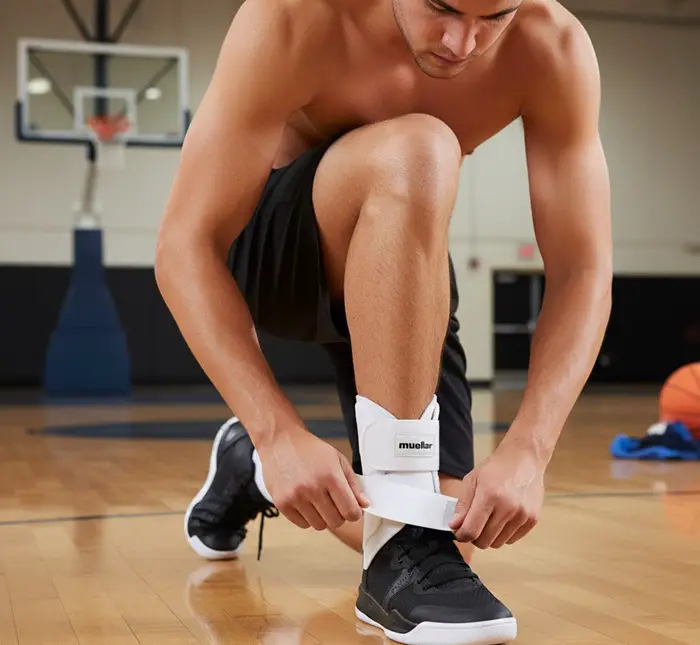
Troubleshooting Common Issues With Mueller Ankle Braces
Keep in mind that even with a correct fit, ankle braces like the Mueller HG80, ATF2, and lace-up models can sometimes feel off—slipping down, feeling too tight, or causing pressure under the arch.
Fortunately, most of these problems come from small fit adjustments and are easy to fix once you know what to look for.
The ankle brace keeps slipping down
One of the most common issues is the brace slipping down during activity. This usually happens when moisture reduces friction, when the laces aren’t tightened evenly from bottom to top, or when the figure-8 straps are wrapped too loosely.
A thin, moisture-wicking athletic sock helps create the right amount of grip, and re-lacing from the very bottom eyelets ensures tension is distributed properly.
Increasing strap tension slightly and making sure the heel is centered deeply in the heel pocket will also greatly reduce slipping.
The Mueller brace feels too tight or causes tingling
Another frequent problem is the brace feeling too tight or causing tingling in the toes. This often occurs when the lower laces are pulled too aggressively or the figure-8 straps are wrapped too tightly under the arch, restricting circulation.
Loosening the bottom half of the laces, rewrapping the straps with moderate and even pressure, and allowing swollen ankles to rest or cool down before bracing usually solves the issue.
As a rule of thumb, if your toes turn pale, cold, or numb, the brace is too tight and needs immediate adjustment.
You experience arch pain or pressure
Some people experience arch pain, which typically happens when the straps are pulled downward too forcefully or wrapped at a steep angle.
Rewrapping the figure-8 straps at a flatter angle—closer to the shoe line—helps distribute pressure more evenly.
Pairing the brace with supportive footwear and ensuring the straps aren’t twisted underneath the foot can also eliminate unnecessary pressure. Minimal or worn-out shoes with collapsed arches may exaggerate discomfort when wearing any ankle brace.
The Mueller brace feels twisted or uneven in the shoe
If the brace feels twisted, uneven, or awkward inside your shoe, the cause is usually something simple like a folded tongue, misaligned heel, or uneven strap tension.
Removing the brace, centering the heel correctly, smoothing the interior padding, and tightening both straps with equal pressure typically corrects the problem.
A supportive shoe with a firm heel counter also helps keep the brace aligned.
Your Mueller ankle brace is not providing enough support, even after tightening
Finally, if the brace doesn’t feel supportive enough even when tightened, the issue may be with the brace model or strap technique rather than the fit. Always double-check the strap direction—the inside strap should go first for correct inversion control.
If the Velcro is worn out or the straps have lost elasticity, the brace may simply be at the end of its life cycle.
For intense sports or frequent sprains, upgrading to a higher-stability option like the Mueller HG80 or ATF2 often provides much stronger support than basic lace-up versions.
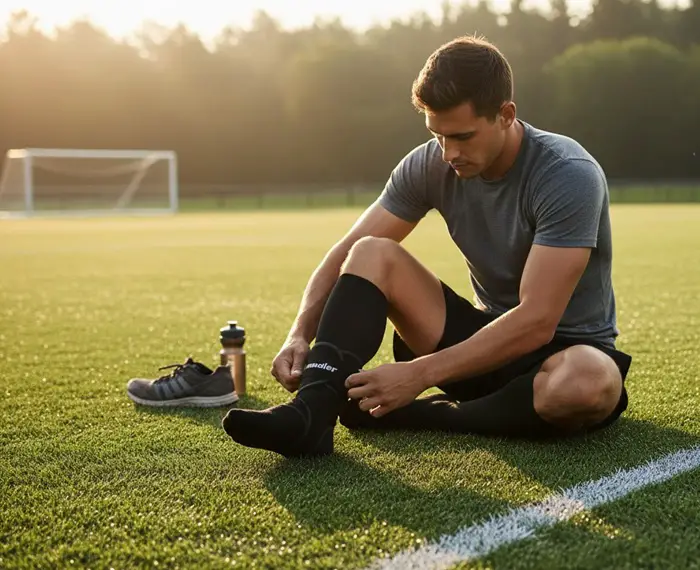
Reviewing The 5 Best Mueller Ankle Braces for High-Performance Athletes
When it comes to ankle support, Mueller is one of those rare brands that athletes, trainers, and orthopedic pros all agree on—almost like the universal “yes, this one actually works” of the brace world.
Their ankle supports are intentionally low-profile, surprisingly lightweight, and engineered with the kind of quiet confidence that only decades of sports-medicine experience can deliver.
Whether you’re dealing with weak ankles, recovering from a sprain, managing arthritis, or simply trying to stay upright during high-intensity sports, Mueller’s designs consistently offer the stability and comfort people swear by.
What sets them apart is their blend of simplicity and performance: clean designs, smart padding, latex-free materials, and a fit that feels more like a supportive wrap than a bulky medical device.
It’s no surprise that everyone—from weekend athletes to orthopedic clinics—leans toward Mueller when injury prevention truly matters.
Below, we break down the best Mueller ankle support braces to help you pick the perfect one for your needs.
1- Mueller Sports Medicine AFT3 Ankle Brace
This is the most appropriate Mueller ankle brace for those searching for a lightweight support that features a low-profile design.
Mueller AFT3 Ankle Brace features an amazing anti-slip side strap to reduce the ankle motion and help protect from sprains.This Mueller ankle support with straps comes with a stirrup strap that pulls the foot up and hence delivers a very sturdy kind of support.
Hence, it imitates the effects of tapping while you get enhanced support from the elastic strap of the top.
This ankle brace from Muller is highly comfortable to wear in shoes or cleats between competitions. The product is made from nylon, polypropylene, and polyester.
As the user, you gain all the traditional taping benefits with its immense flexibility and superior adjustability.
2- Mueller Adjustable Ankle Stabilizer
This Mueller Adjustable Ankle Stabilizer is fully featured as the design is customizable or adjustable.
With this brace, you can enjoy a custom fit with perfect compression. It’s perfect for those who are suffering from some kind of foot or ankle injury or having immense pain in the foot due to a sprain or arthritis.
This Mueller ankle stabilizer is great for extended use since it is lightweight. It may fit any of the foot styles easily.
Featuring brilliant side stays, the Mueller ankle brace provides firm lateral support and also protection.
The figure-eight strapping offers controlled compression and customized support. You enjoy additional stability with the extended height.
The stabilizer stays odorless and fresh when treated by the Aegis Microbe Shield. It may fit the size of 6-15 women’s shoes and 4.5-14 men’s shoes. It is a must-consider product!
3- Mueller Sport Care Ankle Brace
If you are suffering from chronic pain in the talus region, which is restricting you from walking comfortably, you should try out this Mueller 4-way stretch support ankle brace for sure.
The brace is available in small and medium sizes to fit men and women with differently sized ankles, and it can effectively help to enhance the leg and ankle motion.
With this brace, you can easily attain 360-degree compression with the four-way stretch support brace which is magnificent.
Its superior making is the added advantage, and the use of nylon fabric makes it amazingly breathable.
The elasticized brace offers perfect compression and very firm support. You attain both horizontal and vertical compression with the breathable fabric. It is latex-free and spandex-free.
4- Mueller Lite Ankle Brace
Mueller The Light Ankle Brace is perfect for the ones looking for a lightweight brace or comfortably hinged brace since they can get maximum protection with complete ankle flexibility.
Priced favorably, you get better support from the brace. Featuring a padded rigid right support, the brace guards against the inversion sprains, and hinges permit a complete range of motion.
It has one strap for the easy ‘on’ and ‘off.’ The best part is that it fits in most shoes and either foot.
The very concept and the construction of the brace are amazing since it accommodates both narrow and broader feet comfortably. Definitely, it is the coziest brace as per the reviews posted on the major websites.
5- Mueller Ankle Support Neoprene Blend
This Mueller brace offers a non-restricting support while soothing the light compression.When you desire light compression and warmth around the ankle, use the Mueller Ankle brace. Those with broken ankles can get great support from the brace.
When you compare the prices and quality of other braces from Mueller, this one is perfect and has the edge over the others. It offers soft support, and it would be great to wear it under the socks.
It offers stabilization while walking to those with severely swollen ankles.
You can snug the brace around your ankle base and enjoy great support. You can wear it during all kinds of physical activities, supporting mild ankle sprain.
Although it slips on the ankle easily, it provides great stability and strength. Those looking for flexible and concealable support can try it out.
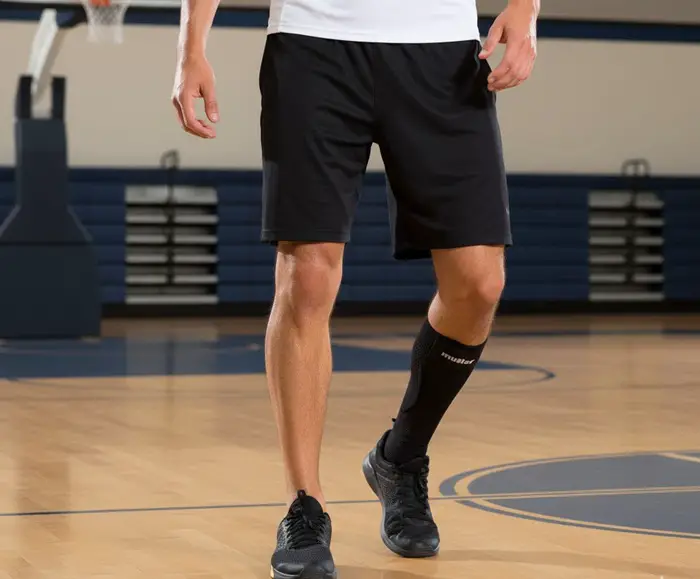
Mueller Ankle Support Brace vs. Sleeves – Which is Better to Prevent Injuries in Sports?
The biggest difference between an ankle sleeve and an ankle support brace (or a lace-up brace) comes down to support level and structure.
Mueller ankle sleeve is made from soft, stretchy compression fabric that provides warmth, light support, and gentle stabilization.
It boosts blood flow, reduces minor swelling, and helps you “feel” your ankle better during movement. However, it has no rigid components, so it cannot stop a strong inward or outward roll.
A Mueller lace-up ankle brace, on the other hand, is built with laces, straps, and sometimes semi-rigid stays.
This design gives it the ability to physically restrict harmful ankle motions, especially inversion and eversion. It offers noticeably stronger protection and is ideal for athletes who need mechanical stability during high-intensity play.
When to use an ankle sleeve?
Use an ankle sleeve when you want light protection and comfort. Sleeves are perfect for mild ankle fatigue, small amounts of swelling, recovery after workouts, or everyday support.
They’re thin, breathable, and fit easily inside almost any shoe, making them great for running, gym workouts, or low-impact sports.
If your goal is to maintain warmth, enhance circulation, and reduce minor discomfort without restricting movement, a sleeve is the ideal choice.
When to use a lace-up ankle brace?
A lace-up ankle brace is better when you need high-level protection. This includes athletes with a history of sprains, chronic instability, or those playing sports with heavy cutting, jumping, and contact—such as basketball, volleyball, soccer, or trail running.
Because lace-up braces limit extreme ankle motion, they provide confidence during intense play and help prevent re-injury. If you want adjustable, strong support that prioritizes stability over flexibility, this is the right option.
Tips for choosing the right fit of ankle sleeve and an ankle brace
Choosing the correct fit is crucial for both comfort and performance. Always measure your ankle circumference according to the manufacturer’s chart instead of guessing.
After sizing, try the sleeve or brace inside the shoe you’ll actually use—many lace-up braces can be bulkier and may not fit tight athletic shoes.
Make sure the brace feels secure without cutting off circulation, and test a few sport-specific movements to check comfort and range of motion.
Breathability also matters for long sessions, so choose materials that won’t trap heat. Finally, replace your brace or sleeve once compression weakens or straps start loosening.
Final Thoughts
Putting on and wrapping a Mueller ankle brace isn’t complicated, but doing it correctly makes all the difference in how well it protects you.
A proper fit ensures the brace delivers the stability, compression, and motion control it’s designed for—especially during quick cuts, jumps, and high-impact movement.
Always start with fully loosened laces, tighten gradually from the bottom up, and secure the straps in a smooth figure-8 pattern for maximum support.
Once wrapped properly, the brace should feel snug, comfortable, and locked in, giving you the confidence to move freely without worrying about your ankle.



